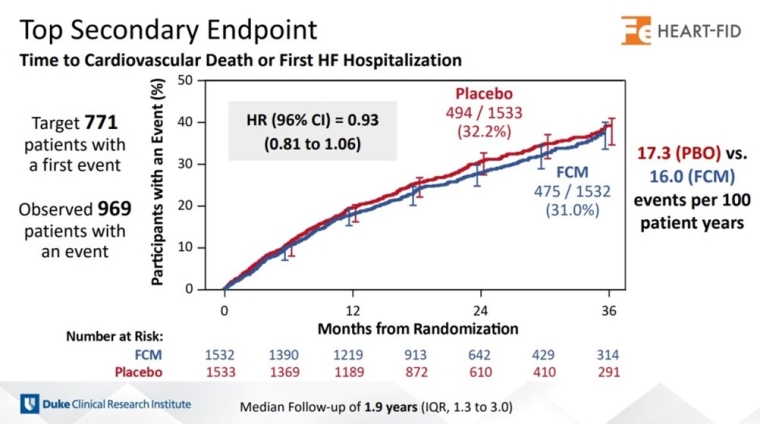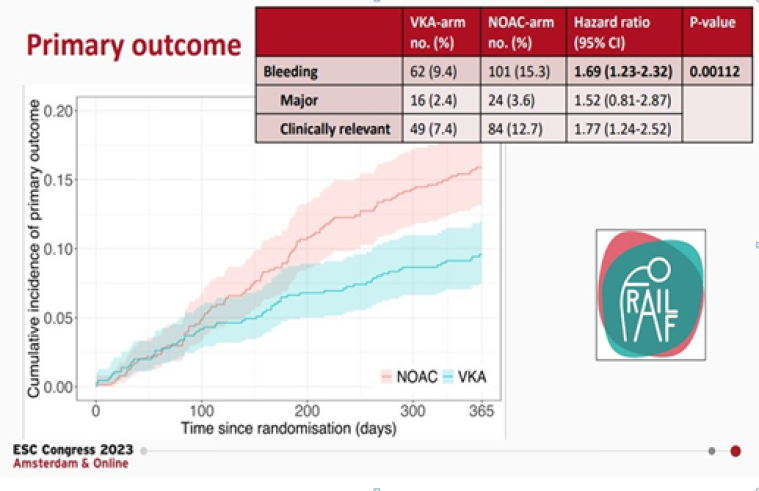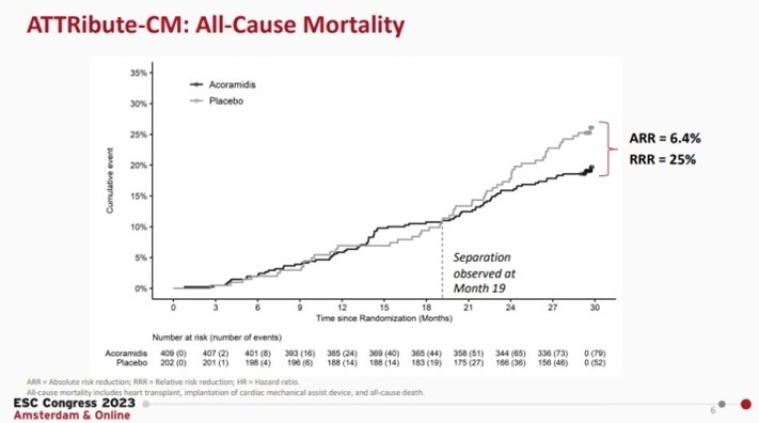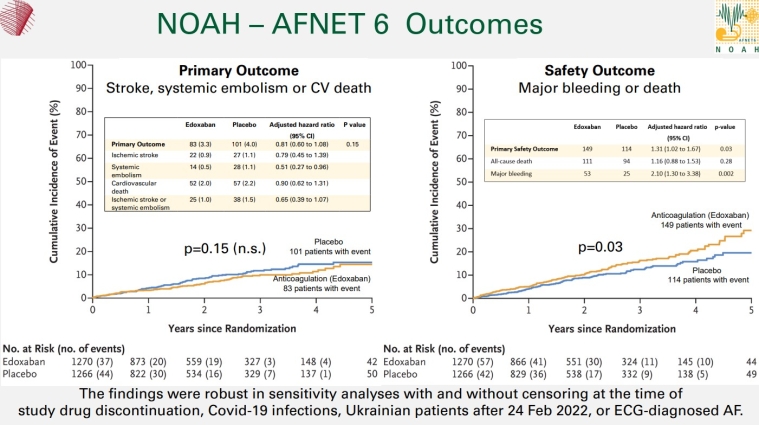Take-home messages
- 2023 ESC Guidelines for the management of cardiovascular disease in patients with diabetes.
- The STEP-HFpEF Trial: once-weekly semaglutide for patients with HFpEF and obesity.
- The HEART-FID Trial: disappointing results from the trial targeting iron deficiency in HF.
- The FRAIL-AF Trial: your frail patient well tolerates an INR-guided VKA treatment - don't switch to a NOAC!
- The ATTRibute-CM Trial: acoramidis shows promising results for transthyretin amyloid cardiomyopathy treatment.
- The NOAH-AFNET 6 Trial: atrial high-rate sub-clinical episodes - oral anticoagulation increases the risk of bleeding without benefit on thrombotic events.
2023 ESC Guidelines for the management of cardiovascular disease in patients with diabetes
The 2023 ESC Guidelines for the management of cardiovascular disease (CVD) in patients with diabetes were released during ESC Congress 2023 in Amsterdam, and are of particular importance for our daily practice.
The first significant change from the previous guidelines, published in 2019, is that prediabetes is not discussed, due to lack of clear evidence.
The second important consideration is that all patients with diabetes should be assessed for the presence of CVD and severe target organ damage, defined by the estimated glomerular filtration rate (eGFR), urinary albumin–to-creatinine ratio (UACR) and the presence of microvascular disease in at least three different sites.
A novel algorithm, SCORE2-Diabetes, is proposed for patients with type 2 diabetes and no atherosclerotic cardiovascular disease (ASCVD) nor target organ damage. It is a 10-year CVD risk score for the classification of patients as low, moderate, high or at very high CV risk.
In patients with diabetes and ASCVD, treatment with sodium-glucose co-transporter-2 inhibitors (SGLT2-i) and glucagon-like peptide-1 receptor agonists (GLP1-RA) is recommended, independent of glucose control and in addition to standard of care.
A systematic search for heart failure (HF) is recommended at each clinical encounter. All diabetic patients with HF, regardless of left ventricular ejection fraction (LVEF), should be treated with SGLT2i to reduce HF hospitalisation and CV death.
Opportunistic screening for atrial fibrillation (AF) by pulse taking or electrocardiogram ECG is recommended in patients with diabetes aged >65 years.
In the presence of chronic kidney disease (CKD), patients should receive SGLT2i and finerenone to reduce CV events and kidney failure risk.
If additional glucose control is needed, metformin should be considered in patients with diabetes mellitus type 2 and ASCVD (Class IIa, Level of Evidence [LoE] C) or pioglitazone (Class IIb, LoE B).
Metformin alone is recommended to be used in low and moderate risk patients.
Metformin in combination with SGLT2I or GLP1RA, or SGLT2I and GLP1RA alone should be used in diabetic patients at high risk (SCORE2-Diabetes >10%).
Only SGLT2I and GLP1RA are recommended for very high-risk patients with diabetes.
Watch the session 2023 ESC Guidelines overview.
(Please note that the ESC will make these resources free of charge for all readers between the 6 October and 1 December 2023. After that time, from 2 December onward, they will only be available for ESC Professional Members.)
The STEP-HFpEF Trial: once-weekly semaglutide for patients with HFpEF and obesity
Patients with HF with preserved ejection fraction (HFpEF) and obesity have a high burden of symptoms and physical limitations leading to a poor quality of life. The double-blind STEP-HFpEF trial included 529 worldwide patients with a body mass index >30kg/m2, New York Heart Association (NYHA) Class II-IV and Kansas City Cardiomyopathy Questionnaire Clinical Summary Score (KCCQ-CSS) <90 points. The patients were randomised to once weekly s.c. semaglutide 2.4mg or placebo for 52 weeks. The two primary endpoints were a change in KCCQ-CSS and body weight from baseline to 52 weeks.
The results showed a mean change in body weight of ‒13.3% in the semaglutide group and ‒2.6% in the placebo group (p<0.001). The change in KCCQ-CSS from baseline to 52 weeks was 16.6 points in the semaglutide group and 8.7 points in the placebo group (p<0.001). The trial also met all secondary endpoints: the 6-minute walk test and the composite endpoint of death, HF events, change in KCCQ-CSS, change in N-terminal pro B-type natriuretic peptide (NT-pro BNP).
Professor Kosiborod concluded: “This is the first trial of a pharmacologic agent to specifically target obesity as a treatment strategy for HFpEF and the magnitude of the observed benefits will likely have a significant impact on clinical practice, especially since there is a dearth of efficacious therapies in this vulnerable patient group. Obesity is not a simple comorbidity in patients with HFpEF but a root cause and a target for therapeutic interventions.”
Figure 1. Change from baseline to week 52 in KCCQ-CSS with dual primary endpoints.

Watch the session on STEP HFpEF in Hotline 1.
(Please note that the ESC will make these resources free of charge for all readers between the 6 October and 1 December 2023. After that time, from 2 December onward, they will only be available for ESC Professional Members.)
The HEART-FID Trial: disappointing results from the trial targeting iron deficiency in HF
This trial included 3,065 patients with a mean age of 69 years, 34% women, heart failure with reduced ejection fraction (HFrEF) and iron deficiency (Hb>9.0g/dl <13g/dl females, or >9.0g/dl <15g/dl males, ferritin<100ng/dl or ferritin 100-300ng/dl with a transferrin saturation [TSAT] <20%) and the maximum tolerated background therapy. Patients were randomised to intravenous (IV) ferric carboximaltose (FCM) or placebo administered at days 0 and 7 and then every 6 months, based on iron indices and haemoglobin levels.
FCM resulted in modest and not significant differences compared to placebo for all composite endpoints, all-cause mortality at 1 year, HF hospitalisation, and 6-minute walk test distance.
Dr. Robert Menz who presented the trial concluded: The HEART-FID trial confirmed the safety of IV FCM in patients with HFrEF but did not meet the efficacy endpoint.
Figure 2. Top secondary endpoint.

Watch the session on HEART-FID in Hotline 2.
(Please note that the ESC will make these resources free of charge for all readers between the 6 October and 1 December 2023. After that time, from 2 December onward, they will only be available for ESC Professional Members.)
The FRAIL-AF Trial
The FRAIL-AF Trial is a Dutch randomised, pragmatic, multicentre, open-label, superiority trial designed to answer the question: “does switching from a vitamin K antagonist (VKA) to a non-vitamin K oral anticoagulant (NOAC) compared to continuing a VKA reduce bleedings in elderly frail patients with AF?” [1].
Note that the trial does not address the choice of the initial anticoagulation strategy in the elderly and frail populations [2-4].
Outpatients ≥75 years, with a Groningen frailty index (GFI) ≥3 and eGFR ≥30 mL/min/1.73 m2 on VKA for non-valvular AF were studied. 662 patients were allocated to continue on VKAs and 668 to switch to NOACs. The general practitioner was allowed to choose the type of NOACs. The primary endpoint was major bleeding or clinically relevant non major (CRNM) bleeding.
At 1-year follow-up, the hazard ratio (HR) for the primary outcome was 1.69 for those switching to a NOAC, relative to continuing the international normalised ratio (INR)-guided VKA treatment (95% confidence interval [CI]: 1.23 to 2.32; p=0.00112), thus showing a better safety profile for the non-switching arm. The results were mainly driven by CRNM (84 cases in the switching arm [12.7%] vs 49 cases [7.4%] in the VKA patients) whereas major bleeding occurred in 24 cases (3.6%) of the switching arm vs 16 cases (2.4%) in the VKA group. Among CRNM, the only location where major bleeding was different between the two groups was the gastrointestinal site: 9 cases (1.4%) on NOACs vs 1 (0.2%) in the arm who continued on VKA.
A few points need to be made:
- A history of major bleeding, a history of thromboembolic events, active cancer, were higher in the switching arm and might account for the difference in CRNM bleeding.
- The definition of frailty may change in different contexts with different tools to investigate specific deficits [5]. The Groningen frailty index ≥3 may not identify a truly frail population, at least, it does not focus on patients with frailty exclusively in the medical and physical domains [6].
- Rivaroxaban accounted for the 50% of the chosen NOACs.
In conclusion, FRAIL-AF shows that switching from VKA to NOACs in frail older patients that are tolerating an INR-guided VKA treatment well increases the risk of bleeding.
Note that the study was not powered to answer to the question: “are NOACs better than VKA in preventing thrombotic stroke, all-cause mortality or major bleedings?” Nevertheless, it considers a special population often neglected by randomised controlled trials who nonetheless represent a vast number of patients in clinical practice; it underlines the need to focus on these specific patients when designing new trials and demonstrates that such studies are now feasible.
Figure 3. Primary Outcome.

Watch the session on FRAIL-AF in Hotline 6.
(Please note that the ESC will make these resources free of charge for all readers between the 6 October and 1 December 2023. After that time, from 2 December onward, they will only be available for ESC Professional Members.)
The ATTRibute-CM Trial: acoramidis shows promising results for transthyretin amyloid cardiomyopathy treatment
Julian Gillmore (London, UK), in presenting the ATTRibute-CM Trial, stated that in patients with transthyretin amyloid cardiomyopathy (ATTR-CM), treatment with acoramidis, a transthyretin (TTR) tetramer stabiliser, reduced cardiovascular disease hospitalisations compared with placebo. Additionally, according to the researcher, patients experienced improved functional capacity and quality of life.
This multicentre trial included 632 patients from the USA, Italy, Australia, and Spain. They were randomised (2:1 ratio) with wild-type or variant symptomatic ATTR-CM to receive either oral acoramidis (800 mg twice daily) or placebo for 30 months. All participants in both groups were able to initiate open-label, commercially available tafamidis after 12 months of the study, if needed. The median age of the participants was 78 years, 90% were male, 10% were variant TTR carriers and most had NYHA Class II (72.0%) or Class III (17.2%) symptoms.
The primary endpoint, targeted at 30 months, was a hierarchical analysis by the Finklestein-Schoenfeld method of all-cause mortality, cardiovascular (CV)-related hospitalisation, NT-proBNP, and 6-minute walk distance. Secondary endpoints included the components of the primary endpoint, KCCQ-CSS, and serum transthyretin levels.
Results uncovered a highly statistically significant primary hierarchical endpoint analysis, resulting in an odds ratio of 1.8 (95% CI: 1.4 to 2.2; p<0.0001). Considering the secondary endpoints, the investigators observed a reduction by about 50% in CV hospitalisations (p<0.001) and a trend to decreased CV mortality (NS). Improvements in NT-proBNP from baseline as well as 6MWD were greater in the acoramidis group. However, no significant impact on all-cause mortality was noted.
Thus, the trial showed that in patients with ATTR-CM, acoramidis was consistently associated with clinical benefits. These positive results were essentially led by the reduction in CV hospitalisations; this effect is consistent amongst key clinical subgroups. However, despite a trend to decreased CV mortality, no impact was noted on all-cause mortality.
Future discussions will focus on the place of acoramidis among existing treatments such as tafamidis and the many other treatments for ATTR-CM currently in development.
Figure 4. ATTRibute-CM: All-Cause Mortality.

Watch the session on Perspectives on current & future pharmacological treatments of ATTR-CM.
(Please note that the ESC will make these resources free of charge for all readers between the 6 October and 1 December 2023. After that time, from 2 December onward, they will only be available for ESC Professional Members.)
The NOAH-AFNET 6 Trial. Atrial high-rate episodes: Is oral anticoagulation related to an increased risk of bleeding?
In patients with subclinical atrial fibrillation (AF) and an elevated risk of stroke, therapeutic strategies to prevent stroke, such as oral anticoagulant drugs, remain unclear.
The NOAH-AFNET 6 trial investigated this important question in an event-driven double-blind, double dummy randomised trial comparing a novel oral anticoagulant (NOAC) versus placebo. Subclinical AF was defined as atrial high-rate episodes (AHRE) >6 minutes and an atrial rate >170/bpm as detected by implanted cardiac devices. Elevated stroke risk was defined as age >65 years plus one additional risk factor for stroke, according to the CHA2DS2VASc score.
The primary efficacy outcome was a composite of cardiovascular death, stroke, or systemic embolism. A total of 2,536 patients were randomised. The trial has been stopped early due to safety concerns and elevated bleeding risk in the edoxaban group.
In conclusion, patients in both groups had a low stroke risk of approximately 1% and oral anticoagulation did not reduce the primary endpoint but increased the risk of bleeding.
Figure 5. NOAH – AFNET 6 Outcomes.

Watch the session on NOAH-AFNET 6 from Hotline 1.
(Please note that the ESC will make these resources free of charge for all readers between the 6 October and 1 December 2023. After that time, from 2 December onward, they will only be available for ESC Professional Members.)





 Our mission: To reduce the burden of cardiovascular disease.
Our mission: To reduce the burden of cardiovascular disease.